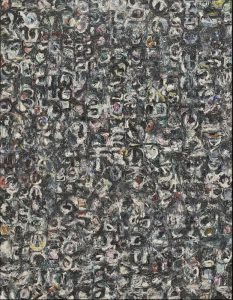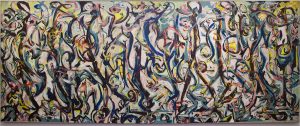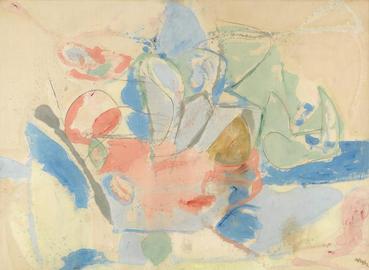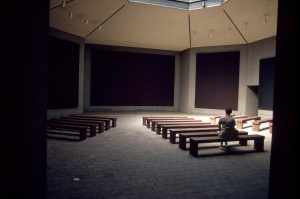9.1 Making an American Art – Abstract Expressionism
For an introduction:
Read Design and post-modernity, 1945–1990 Sparke, P. (2019). An Introduction to Design and Culture: 1900 to the Present (4th ed.). Routledge. https://doi.org/10.4324/9781351023306
is as diverse as the artist who claims to be an abstract expressionist. Painting became an event, something to throw, something to explore, something to express, creating the term ‘action painting’. It was also a reaction to the political movement during the 1960s in America and revitalized the art world. Some artists considered painting a physical as seen in the large canvases of Pollock; others were expressing their subconscious interpretations in their artwork.



During the depression, she worked on the WPA Art Project, creating large murals. It was hard for an abstract expressionist to paint the figurative scene, but Krasner needed to support herself. Becoming a member of the Artists Union in New York helped her meet other abstract artists, including her future husband and artist, Jackson Pollack.
She divided her work into different stages or series. In her first series, Krasner worked on canvas and added paint, scraped and rubbed it off, and added more and continued the cycle so the work would become gray from so many paint layers. She destroyed these works, and only one survives today. Her next series was the Little Image series of about forty paintings. She built up thick paint with hieroglyphs and added drips to the images. With so much paint, she again ended up with a little variation of color but much texture.
In the early 1950s, she created a series of collage paintings. She pasted cut and torn shapes on the canvas and added color with paint. She contrasted light and dark colors and made soft and hard lines. After her husband, Pollack, died in a car accident, Krasner began the Earth Green series. The intense emotional brush strokes on the extra-large canvas and unconventional self-expression with paint drips portrayed her feelings. Shattered Color (14.20) is an example of her chunky spots of paint applied in multiple colors. She struggled as an artist in the shadow of Pollack and being labeled his wife first and an artist second. Krasner continued to paint until her death in 1984. The parody of Alice in Wonderland(14.21) is an example of Krasner’s use of hard-edge lines with open spaces and exaggerated forms.
IN LEE KRASNER: LITTLE IMAGE PAINTINGS 1946-1950, AUG. 1-OCT. 31, 2008, AT THE POLLOCK-KRASNER HOUSE AND STUDY CENTER, POLLOCK-KRASNER HOUSE, EAST HAMPTON, NY, 2008. https://gaillevin.commons.gc.cuny.edu/publications-2/monographs-and-catalogues/

Paul Jackson Pollock (1912–1956) was an American painter in abstract expressionism and well-known for his style of drip painting, as seen in Alchemy (14.22). He usually tacked a large piece of canvas to the floor and poured paint on the canvas, moving it around with a stick. The painting has layers of paint, each layer building the depth on the canvas. Using the same technique, Greyed Rainbow (14.23) displays thick chunks of paint interspersed with thin meandering lines in gray, white, and black. Hidden near the bottom are multiple bright colors. Pollack seems to have broken through the glass ceiling in art with his ‘drip’ paintings and went on to become a famous painter in his own time, even though he died relatively young in a car accident in 1956. He became the symbol of American abstract painting.

Mark Rothko (1903 – 1970) was an American painter of Russian-Jewish descent. Rothko was part of the abstract expressionism movement and was influenced by ‘primitive’ art and color. The organic paintings appear to have only a few simple colors (14.24, 14.25), yet the effects of the simplistic outer color are the brilliance of the under colors. The paintings are devoid of any figures or shapes; it is a silence of color, yet the color is screaming at the same time. There is not a top or bottom and must be seen in person to understand and admire the work.
Rothko was intent on making art that was different because he felt art had hit a dead end. Commercialism and visual images were everywhere, and Rothko’s paintings provided a respite for the viewer, cut through the white noise of everyday life, and made the multi-forms of color meant to overwhelm the viewer. Despite his fame, Rothko died by suicide in 1970 after painting 836 canvases.
Colour Field Painting

Helen Frankenthaler (1928-2011) was born in New York and studied art at the university, recognized early in her life as an accomplished artist shown in significant exhibitions. Mountains and Sea (14.26) was her innovative abstract painting created on a large canvas she laid on the floor, layered with applications of thinned paint she called a soak-stain painting. Working from all sides of the canvas, Frankenthaler was able to float different colors as she walked around, giving the painting a translucent appearance. In her workshop, she painted on a wide range of materials, sculpted, and worked extensively with woodcuts.


